
|
Astronomy Picture Of the Day (APOD)
 Jet Near Light Speed
Jet Near Light Speed
24.11.1997
Einstein's Special Theory of Relativity says that nothing can travel faster than the speed of light. Jets of protons and electrons that shoot away from objects such as quasars and black holes appear to travel at speeds approaching this maximum speed, though. Such jets carry tremendous energy and can ram straight through interstellar material.
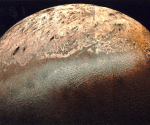 Triton: Neptune's Largest Moon
Triton: Neptune's Largest Moon
23.11.1997
On October 10th, 1846, William Lassell was observing the newly discovered planet Neptune. He was attempting to confirm his observation, made just the previous week, that Neptune had a ring. But this time he discovered that Neptune had a satellite as well.
 Surveyor Hops
Surveyor Hops
22.11.1997
This panorama of the cratered lunar surface was constructed from images returned by the US Surveyor 6 lander. Surveyor 6 was not the first spacecraft to accomplish a soft landing on the Moon ... but it was the first to land and then lift off again!
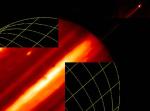 Jupiter: Moon, Ring, and Clouds
Jupiter: Moon, Ring, and Clouds
21.11.1997
An inner moon, an edge-on, planet-girdling ring, and high altitude cloud bands are visible in this mosaic of infrared images of gas giant Jupiter. The moon Metis, 25 miles wide and about 80,000 miles from the planet, is the bright spot at the upper right.
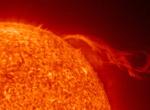 Escape From The Sun
Escape From The Sun
20.11.1997
Twisted magnetic fields arching from the solar surface can trap ionized gas, suspending it in huge looping structures. These majestic plasma arches are seen as prominences above the solar limb. On September 14, this...
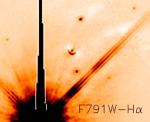 Diffraction Spikes: When Stars Look Like Crosses
Diffraction Spikes: When Stars Look Like Crosses
19.11.1997
Unusual appendages around bright stars are commonplace, but never seem to be mentioned. What are they? First, a telescope brings starlight falling over a large area to a small area. To get at this...
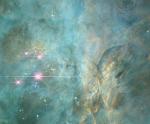 In the Center of the Trapezium
In the Center of the Trapezium
18.11.1997
Start with the constellation of Orion. Below Orion's belt is a fuzzy area known as the Great Nebula of Orion or M42. In this nebula is a bright star cluster known as the Trapezium, shown above. New stellar systems are forming there in gigantic globs of gas and dust known as Proplyds.
 Barringer Crater on Earth
Barringer Crater on Earth
17.11.1997
What happens when a meteor hits the ground? Usually nothing much, as most meteors are small, and indentations they make are soon eroded away. 49,000 years ago, however, a large meteor created Barringer Meteor Crater in Arizona, pictured above. Barringer is over a kilometer across.
 The Leonid Meteor Shower
The Leonid Meteor Shower
16.11.1997
The Leonid Meteor Shower will likely reach its peak in the early hours this Monday morning. Though the Moon will be bright, Leo, the shower's radiant point, will be well above the eastern horizon from Western North America and the Pacific region during this period.
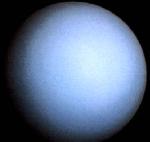 Uranus: The Tilted Planet
Uranus: The Tilted Planet
15.11.1997
Uranus is the third largest planet after Jupiter and Saturn. This picture was snapped by the Voyager 2 spacecraft in 1986 - the only spacecraft ever to visit Uranus. Uranus has many moons and a ring system. Uranus is composed mostly of rock and ices, but with a thick hydrogen and helium atmosphere.
|
January February March April May June July August September October November December |
|||||||||||||||||||||||||||||||||||||||||||||||||